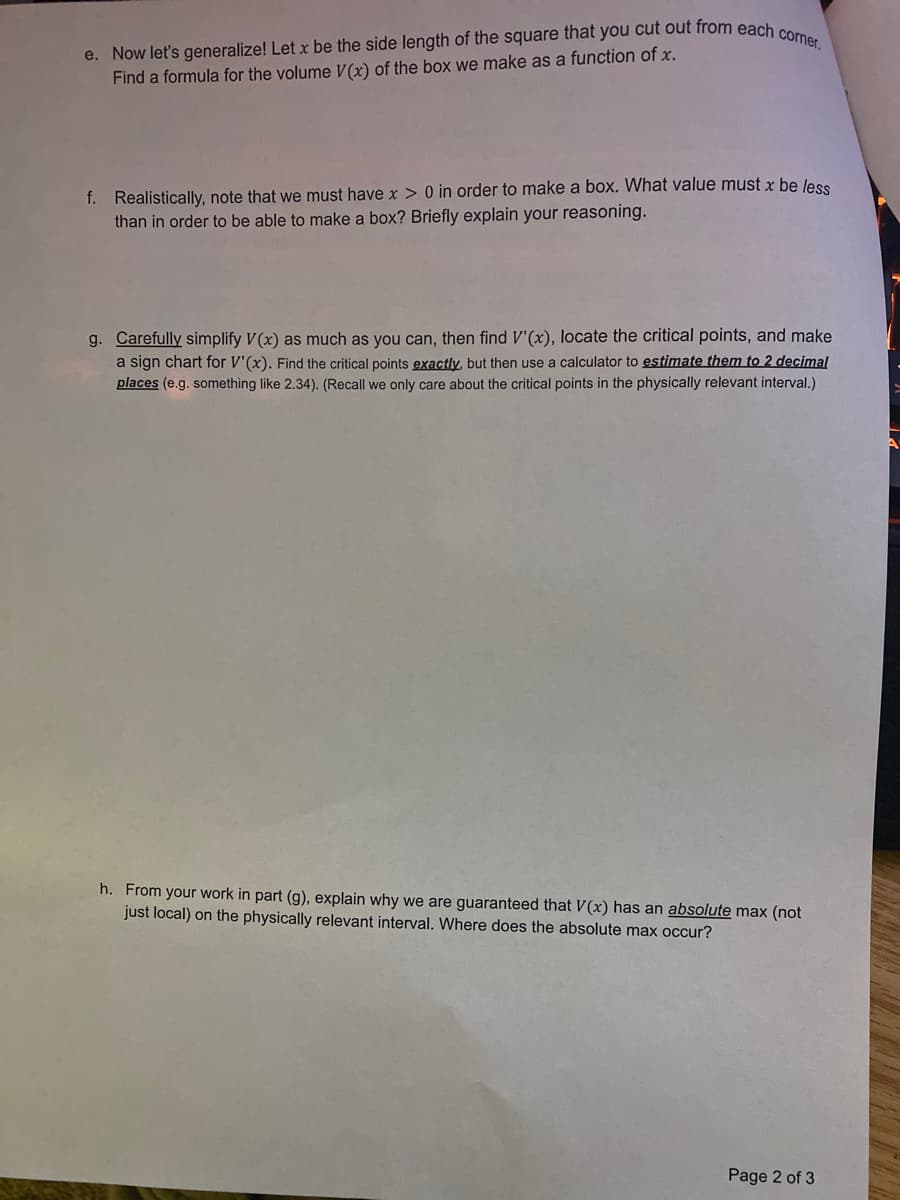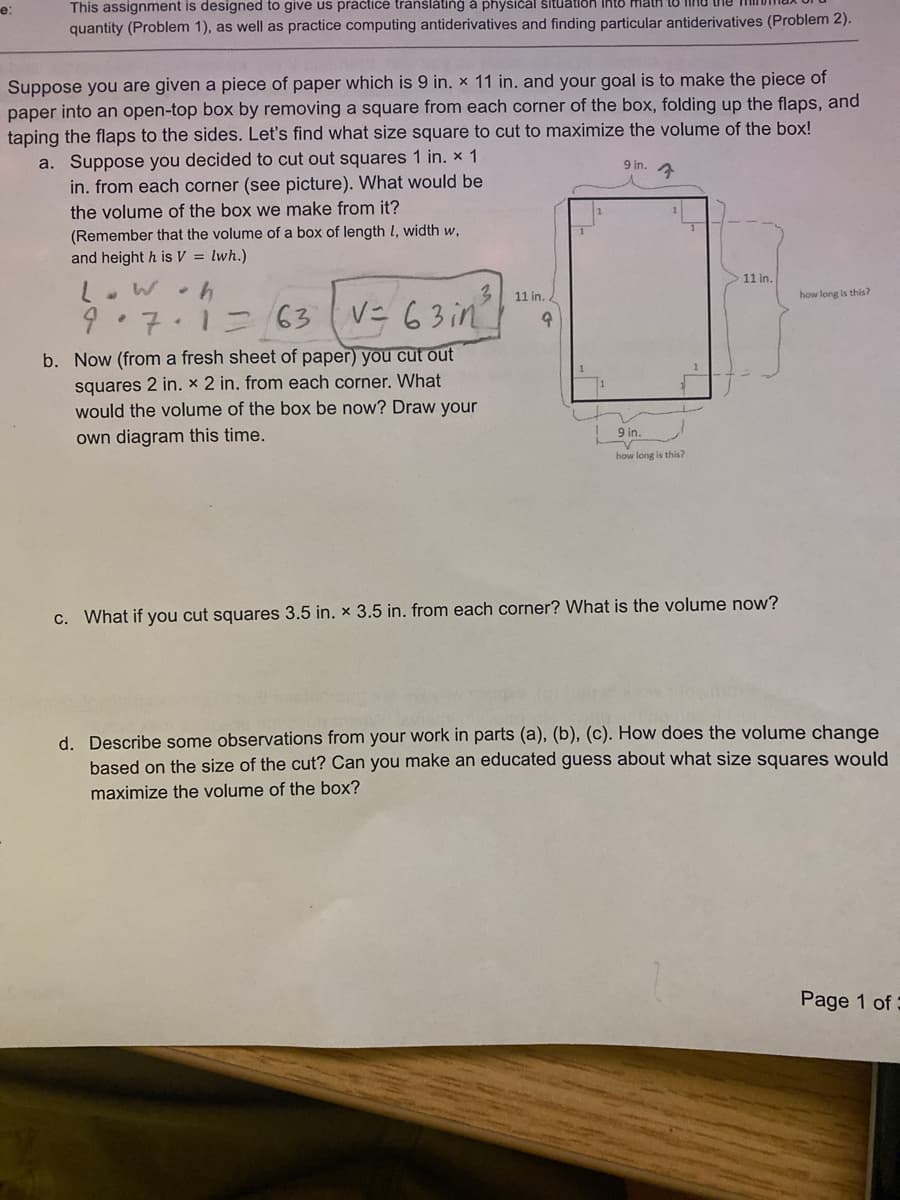Suppose you are given a piece of paper which is 9 in. x 11 in. and your goal is to make the piece of paper into an open-top box by removing a square from each corner of the box, folding up the flaps, and taping the flaps to the sides. Let's find what size square to cut to maximize the volume of the box!
Suppose you are given a piece of paper which is 9 in. x 11 in. and your goal is to make the piece of paper into an open-top box by removing a square from each corner of the box, folding up the flaps, and taping the flaps to the sides. Let's find what size square to cut to maximize the volume of the box!
Algebra: Structure And Method, Book 1
(REV)00th Edition
ISBN:9780395977224
Author:Richard G. Brown, Mary P. Dolciani, Robert H. Sorgenfrey, William L. Cole
Publisher:Richard G. Brown, Mary P. Dolciani, Robert H. Sorgenfrey, William L. Cole
Chapter4: Polynomials
Section4.9: Area Problems
Problem 11P
Related questions
Question
Need help with g and h

Transcribed Image Text:the square that you cut out from each corner.
e. Now let's generalize! Let x be the side length
Find a formula for the volume V(x) of the box we make as a function of x.
f. Realistically, note that we must have x > 0 in order to make a box. What value must x be less
than in order to be able to make a box? Briefly explain your reasoning.
g. Carefully simplify V (x) as much as you can, then find V'(x), locate the critical points, and make
a sign chart for V'(x). Find the critical points exactly, but then use a calculator to estimate them to 2 decimal
places (e.g. something like 2.34). (Recall we only care about the critical points in the physically relevant interval.)
h. From your work in part (g), explain why we are guaranteed that V(x) has an absolute max (not
just local) on the physically relevant interval. Where does the absolute max occur?
Page 2 of 3

Transcribed Image Text:This assignment is designed to give us pračtice tránšláting à physical šituation Ihto matH TU Inu the mil
quantity (Problem 1), as well as practice computing antiderivatives and finding particular antiderivatives (Problem 2).
е:
Suppose you are given a piece of paper which is 9 in. x 11 in. and your goal is to make the piece of
paper into an open-top box by removing a square from each corner of the box, folding up the flaps, and
taping the flaps to the sides. Let's find what size square to cut to maximize the volume of the box!
a. Suppose you decided to cut out squares 1 in. x 1
in. from each corner (see picture). What would be
the volume of the box we make from it?
9 in.
(Remember that the volume of a box of length l, width w,
and height h is V = lwh.)
11 in.
11 in. .
how long is this?
ニ 63 (
V= 63 in
7.12
b. Now (from a fresh sheet of paper) you cut out
squares 2 in. x 2 in. from each corner. What
would the volume of the box be now? Draw your
9 in.
own diagram this time.
how long is this?
c. What if you cut squares 3.5 in. x 3.5 in. from each corner? What is the volume now?
d. Describe some observations from your work in parts (a), (b), (c). How does the volume change
based on the size of the cut? Can you make an educated guess about what size squares would
maximize the volume of the box?
Page 1 of
Expert Solution
This question has been solved!
Explore an expertly crafted, step-by-step solution for a thorough understanding of key concepts.
Step by step
Solved in 3 steps with 2 images

Recommended textbooks for you

Algebra: Structure And Method, Book 1
Algebra
ISBN:
9780395977224
Author:
Richard G. Brown, Mary P. Dolciani, Robert H. Sorgenfrey, William L. Cole
Publisher:
McDougal Littell

Trigonometry (MindTap Course List)
Trigonometry
ISBN:
9781305652224
Author:
Charles P. McKeague, Mark D. Turner
Publisher:
Cengage Learning

Algebra: Structure And Method, Book 1
Algebra
ISBN:
9780395977224
Author:
Richard G. Brown, Mary P. Dolciani, Robert H. Sorgenfrey, William L. Cole
Publisher:
McDougal Littell

Trigonometry (MindTap Course List)
Trigonometry
ISBN:
9781305652224
Author:
Charles P. McKeague, Mark D. Turner
Publisher:
Cengage Learning